No Sulfur Winemaking in Chardonnay (2017)
Matthieu Finot
King Family Vineyards
Summary
This study examines the effect of fermenting wine with and without sulfur dioxide. Chardonnay grapes were harvested and pressed into 3 separate tanks. At pressing, one treatment received 3g/hL sulfur dioxide (control), and the other did not receive any sulfur dioxide, and the third did not receive any sulfur dioxide and received Stab Micro M and Tan Blanc at pressing and followed an Enartis no sulfur winemaking protocol. After settling, the juices were racked into barrel and inoculated with CY 3079. The Enartis wine received additions of Claril SP during settling. After completion of malolactic conversion, the control wine was stabilized with sulfur dioxide, and the Enartis treatment had Stab SLI, Tan SLI, and Stab Micro added at the end of malolactic conversion. Both barrels with the Enartis treatment fermented slower than the rest. No major chemistry differences were found between wines except for slightly lower lactic acid in the Enartis wine. The no sulfur wine had slightly higher levels of Lactic Acid Bacteria, slightly less O. oeni, and slightly less S. cerevisiae. The Enartis wine had slightly more S. cerevisiae, and slightly higher diacetyl. In general, judges were able to distinguish between the wine made with and without sulfur dioxide. This may have been due to a perceptible difference in diacetyl between these two wines, likely due to diacetyl binding by sulfur dioxide in the wine produced with sulfur dioxide. The no sulfur wine treatment may have had slight oxidation (but not in a negative respect), and the Enartis no sulfur wine may have had a slight bitterness (although this was not examined statistically). A perceived bitterness in the Enartis wine may be due to the use of sacrificial tannin. Preferences were not strong, but there seemed to be a preference for the wine made with sulfur dioxide, and then perhaps followed by the wine made without sulfur dioxide. However, many more studies are needed to further qualify how no sulfur winemaking impacts wine sensory qualities. Additionally, more studies need to be performed to determine how no sulfur wines age over time.
Introduction
Producing wine without sulfur dioxide can have an impact on wine flavor and style. Furthermore, no sulfur wines may have marketability niches for consumers. However, no sulfur winemaking also carries with it many risks. No sulfur wines are at greater risk for microbial spoilage, and no sulfur wines are also more prone to perceptible oxidation compared to wines produced with sulfur dioxide. These challenges can be mitigated in part by many procedural factors, such as through using clean grapes, rigorous cellar cleanliness, keeping pH low, fermenting to high alcohol, careful oxygen and inert gas management, and prudent aging practices to minimize oxidative and microbial spoilage. Furthermore, several enological products can be added during different stages of the winemaking process to further reduce spoilage chances. For example, sacrificial tannin or glutathione may be added to help protect the wine against oxidation, and certain additives such as chitosan and lysozyme may further help reduce microbial spoilage risk or intensity. This study compares three different winemaking techniques and their impact on resulting white wine quality: traditional sulfur dioxide usage, no sulfur dioxide usage, and an Enartis protocol involving the use of sacrificial tannin and microbial fining agents.
Results and Discussion
Both barrels with the Enartis treatment fermented slower than the rest. No major chemistry differences were found between wines except for slightly lower lactic acid in the Enartis wine. The no sulfur wine had slightly higher levels of Lactic Acid Bacteria, slightly less O. oeni, and slightly less S. cerevisiae. The Enartis wine had slightly more S. cerevisiae, and slightly higher diacetyl. However, these diacetyl differences may be a function of when they were sampled, and thus these diacetyl numbers may not be representative of how it was perceived during the tastings.
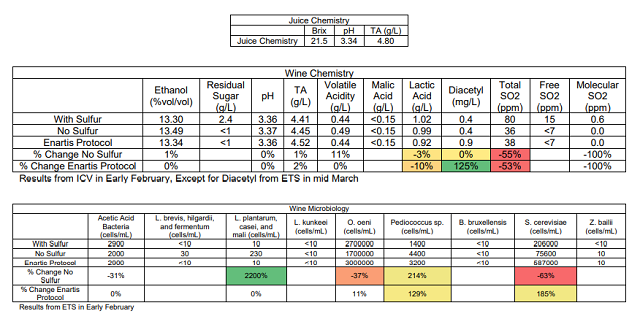
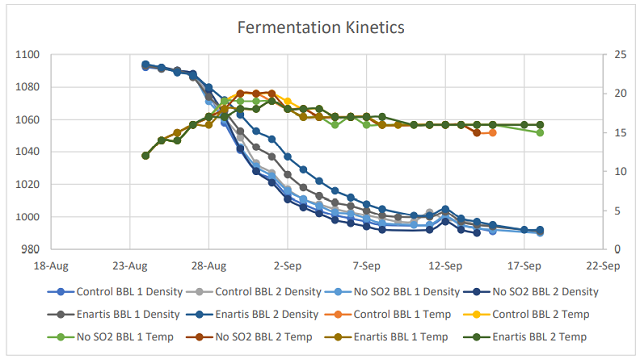
On the February 7 tasting, the Enartis treatment was not tasted because it had not yet completed malolactic conversion. For the triangle test on February 7, of 25 people who answered, 21 people chose the correct wine (84%), showing a statistically significant difference between wines (p<0.001). These wines were voted to have an average degree difference of 4.45 (out of 10), suggesting that the wines were moderately different. In general, people who answered correctly equally preferred both wines.
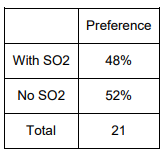
For the descriptive analysis on February 7, there were no strong trends for the descriptors used in this study. There was a slight tendency for the no sulfur wine to have higher Overall Aromatic Intensity. This may have been due to a buttery note perceived in this wine, perhaps due to diacetyl not having sulfur dioxide to bind with, relative to the control where this descriptor was not found much. This interpretation is supported by the similar levels of diacetyl between wines, although diacetyl was measured a month after this tasting and so the measurements may not be representative of where they were during tasting.
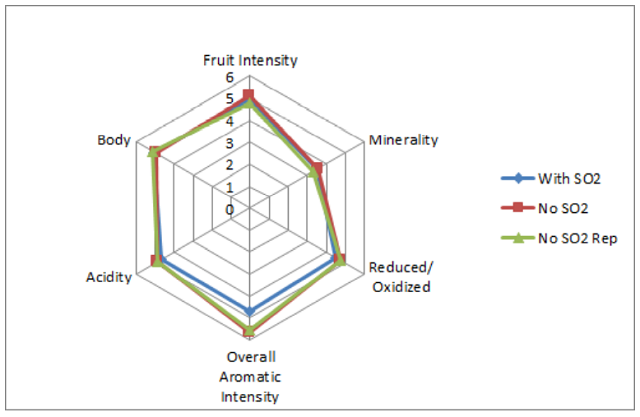
The Enartis wine was tasted on February 28. For the descriptive analysis on February 28, there were no strong trends for the descriptors used in this study. There was a slight trend for wine made with sulfur dioxide to have slightly higher perceived Acidity. In general, the wine made with sulfur dioxide was the most preferred, and the Enartis Protocol was least preferred. At the tasting, the no sulfur wine was described as being slightly oxidized and to have a diacetyl note. The Enartis wine was not described this way, but it may have had a bitterness.
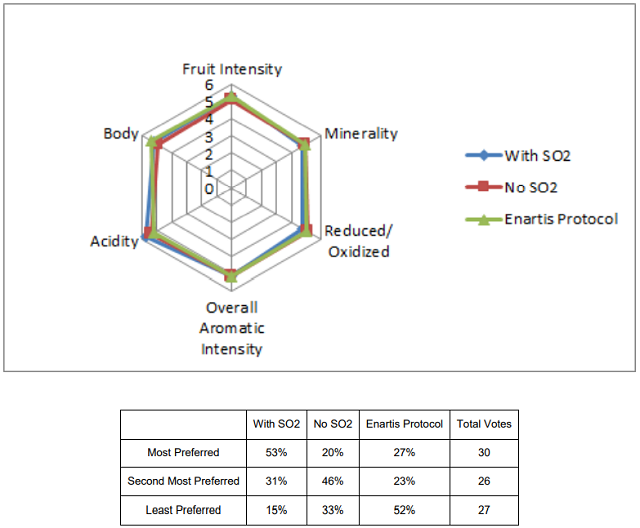
In general, judges were able to distinguish between the wine made with and without sulfur dioxide. This may have been due to a perceptible difference in diacetyl between these two wines, likely due to diacetyl binding by sulfur dioxide in the wine produced with sulfur dioxide. The no sulfur wine treatment may have had slight oxidation (but not in a negative respect), and the Enartis no sulfur wine may have had a slight bitterness (although this was not examined statistically). A perceived bitterness in the Enartis wine may be due to the use of sacrificial tannin. Preferences were not strong, but there seemed to be a preference for the wine made with sulfur dioxide, and then perhaps followed by the wine made without sulfur dioxide. However, many more studies are needed to further qualify how no sulfur winemaking impacts wine sensory qualities. Additionally, more studies need to be performed to determine how no sulfur wines age over time.
Methods
3.095 tons of Chardonnay grapes were harvested on August 21, 2017, stored overnight and whole cluster pressed on August 22. Light press fraction from 1.445 tons was split into three fermentation tanks with the following treatments:
- One received 3g/hL sulfur dioxide
- One received no sulfur dioxide at crush
- One followed an Enartis no sulfur dioxide protocol (Enartis 2017), and received 20g/hL Stab Micro M and 10g/hL Tan Blanc added to the press pan and 16g/hL Claril SP in the clarification tank.
All received 40ppm Lafazyme Press, and juice was analyzed. The wine settled overnight and was racked the following day into identical barrels. NTU for all treatments was adjusted to 100. Each treatment was racked into two identical barrels, and all sampling performed was divided evenly among barrels and blended together, so that each treatment is a representative sample of both barrels. Upon transfer, the wines were inoculated with CY 3079 at 15g/hL, along with Go-Ferm Evolution at 20g/hL. On August 27, all wines received 0.67g/L Tartaric Acid. On September 2, 3g/L Fresharom was added to the no sulfur treatment and 20g/hL Pro FT was added to the Enartis treatment. On 9/18, wine was topped with Chardonnay from another barrel. Malolactic conversion began on October 4 in the no sulfur and Enartis treatment, November 2 in the control, and on December 13 50ppm sulfur dioxide was added to the control. The Enartis fermentation was sluggish, and on January 18, 2018 30g/hL Stab SLI, 2g/hL Tan SLI, and 3g/hL Stab Micro was added to the Enartis treatment.
These wines were tasted on February 7 and 28. For the triangle test, descriptive analysis, and preference analysis for the February 7 tasting, anybody who did not answer the form were removed from consideration for both triangle, degree of difference, and preference. Because the Enartis wine was sluggish, this was not tasted at that tasting. Additionally, anybody who answered the triangle test incorrectly were removed from consideration for degree of difference and preference. Additionally, any data points for preference which did not make sense (such as a person ranking a wine and its replicate at most and least preferred, when they correctly guessed the odd wine) were removed. For this tasting, only the control and no sulfur treatments were tasted, but in future tastings the Enartis sample treatment was also tasted (all wines were resampled at a later date for this purpose).
In order to balance the data set to perform statistical analysis for descriptive analysis on the February 7 tasting, any judge who had not fully completed the descriptive analysis ratings were removed. In order to then make the number of judges between groups equivalent, three judges from group 3 was transferred to group 1. This resulted in a final data set of 3 groups, each with 8 judges (considered as replications within groups, and groups were considered as assessors). Data was analyzed using Panel Check V1.4.2. Because this is not a truly statistical set-up, any results which are found to be statistically significant (p<0.05) will be denoted as a “strong trend” or a “strong tendency,” as opposed to general trends or tendencies. The statistical significance here will ignore any other significant effects or interactions which may confound the results (such as a statistically significant interaction of Judge x Wine confounding a significant result from Wine alone). The descriptors used in this study were Fruit Intensity, Minerality, Reduced/Oxidized, Overall Aromatic Intensity, Acidity, and Body.
The same procedures for data analysis were used on the February 28 tasting, except that the Enartis Protocol wine was also tasted, and that all wine samples were re-sampled at the same time point. For the descriptive analysis in this tasting, one judge was transferred from group 2 to group 3, and one judge was eliminated from group one so that each group had 8 judges, for a total of 24 judges.
References
Enartis. 2017. Winemaking protocol: Low/No SO2 wines -white/rosé. 2017 Vintage. Enartus USA.
